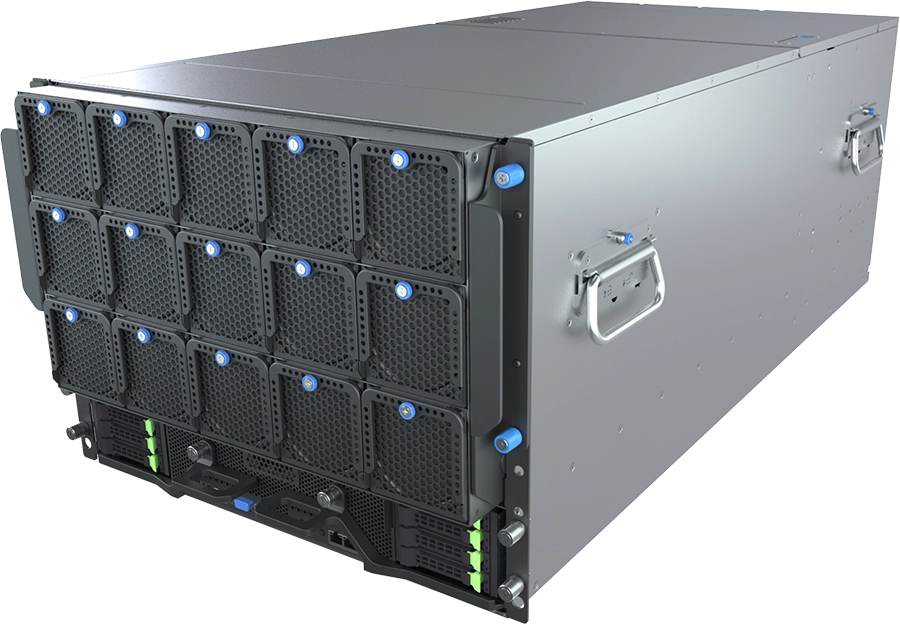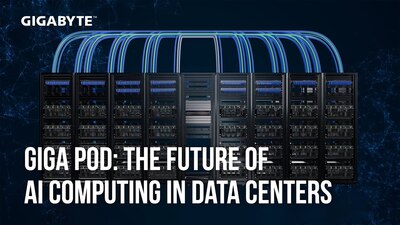GIGABYTE Solutions for NVIDIA Blackwell GPUs: Empowering the Next Era of AI
A GPU Accelerated Era
Breaking Barriers in Accelerated Computing and Generative AI
 Blackwell-architecture GPUs
Blackwell-architecture GPUs
208 billion transistors with TSMC 4NP process
 2nd Gen Transformer Engine
2nd Gen Transformer Engine
Doubling the performance with FP4 enablement
 5th Gen NVLink & NVLink Switch
5th Gen NVLink & NVLink Switch
1.8 TB/s GPU-GPU interconnect
 RAS Engine
RAS Engine
100% In-system self-test
 Secure AI
Secure AI
Full performance encryption & TEE
 Decompression Engine
Decompression Engine
800 GB/s
GIGABYTE's Commitment to Flexible and Scalable Solutions
 Short TTM for Agile Deployment
Short TTM for Agile Deployment
GIGABYTE is dedicated to delivering short time-to-market (TTM) solutions to address the rapidly evolving demands of the computing landscape. Leveraging extensive expertise in server design for diverse applications, GIGABYTE customizes server configurations to specific use cases, reducing costs, streamlining the design processes, and enabling flexible customization with minimal modifications. This ensures an ideal path for customers seeking swift adoption of the latest technologies.
 Flexible Scalability for Diverse Scenarios
Flexible Scalability for Diverse Scenarios
Understanding the growing importance of scalability, GIGABYTE servers are built with future expansion in mind. Equipped with ample expansion slots, these servers maximize interconnectivity, particularly for GPUs, ensuring seamless communication between servers for superior performance.
Comprehensive One-Stop Service for Optimized Configuration

NVIDIA GB200 NVL72: The Pinnacle of Rack-Scale Design

As the flagship product in the Blackwell lineup, the NVIDIA GB200 NVL72 boasts a fully liquid-cooled design and it uses an Arm-based NVIDIA Grace™ CPUs. This rack-scale configuration interconnects all nodes using the latest NVIDIA NVLink™ technology, delivering the performance of “one big GPU.”
This cutting-edge solution outperforms the previous-generation NVIDIA HGX™ H100 GPU by 30x in inference and 4x in training, all while achieving a 25x reduction in TCO. With unmatched interconnect speeds and energy efficiency, the GB200 NVL72 sets a new benchmark for AI and HPC workloads.

XN14-CB0-LA01 Compute Tray
- 2 x NVIDIA GB200 Grace™ Blackwell Superchip
- 2 x 372 GB HBM3e GPU memory with 16 TB/s bandwidth
- 2 x 480 GB LPDDR5X CPU memory with 1,024 GB/s bandwidth
- 8 x E1.S Gen5 NVMe drive bays
NVIDIA HGX™ B200: Accelerating AI with Unmatched Performance
- Support for full-height add-in cards, accommodating DPUs and SuperNICs.
- A PCIe cage design and front-access motherboard/GPU trays for streamlined maintenance.
- Hot-swappable, fully redundant PSUs with multiple connector options for enhanced flexibility.

NVIDIA HGX™ B200 8-GPU
- 8 x NVIDIA Blackwell GPUs
- 1,440GB of GPU memory
- 72 petaFLOPS training performance
- 144 petaFLOPS inference performance
- 1,800GB/s GPU-to-GPU bandwidth with NVIDIA® NVLink™ and NVSwitch™

G893 8U HPC/AI Server
- NVIDIA HGX™ B200 8-GPU
- Dual 5th/4th Gen Intel® Xeon® Scalable or Dual AMD EPYC™ 9005/9004 Series CPUs
- Compatible with NVIDIA® BlueField®-3 DPUs and ConnectX®-7 NICs
- 2 x 10Gb/s LAN ports
- 8 x 2.5" Gen5 NVMe hot-swap bays
- 12 x FHHL PCIe Gen5 x16 slots
- 12 x 3000W 80 PLUS Titanium redundant PSUs

G4L3 4U HPC/AI Server
- Liquid-cooled NVIDIA HGX™ B200 8-GPU
- Dual 5th/4th Gen Intel® Xeon® Scalable or Dual AMD EPYC™ 9005/9004 Series CPUs
- Compatible with NVIDIA® BlueField®-3 DPUs and ConnectX®-7 NICs
- 2 x 10Gb/s LAN ports
- 8 x 2.5" Gen5 NVMe hot-swap bays
- 12 x FHHL PCIe Gen5 x16 slots
- 8 x 3000W 80 PLUS Titanium redundant PSUs
The Power of Acceleration with Blackwell
-
HPC
Complex problem-solving in HPC applications use numerical methods, simulations, and computations to achieve significant insights. While traditionally less dependent on GPUs, the overwhelming parallel computing power of GPGPUs has greatly accelerated the development of HPC in recent years, making hybrid configurations a growing trend in modern supercomputers.
-
AI
With the rapid adoption of AI, from general applications to the fast-evolving deep learning, GPGPUs have become a game changer for the industry. The parallel processing capabilities of GPGPUs allow for the handling of massive datasets and complex algorithms, which are essential for training and deploying AI models. As a result, AI has become the key to making modern systems faster and “smarter” in the most efficient way.
-
Science & Engineering
Research in fields such as physics, chemistry, geology, and biology greatly benefit with the use of GPU accelerated clusters. Simulations and modeling thrive with the parallel processing capability of GPUs, enabling faster computation and more accurate results. This allows researchers to analyze vast datasets, conduct detailed experiments, and achieve breakthroughs across various scientific disciplines efficiently.
Featured New Products
Resources

























